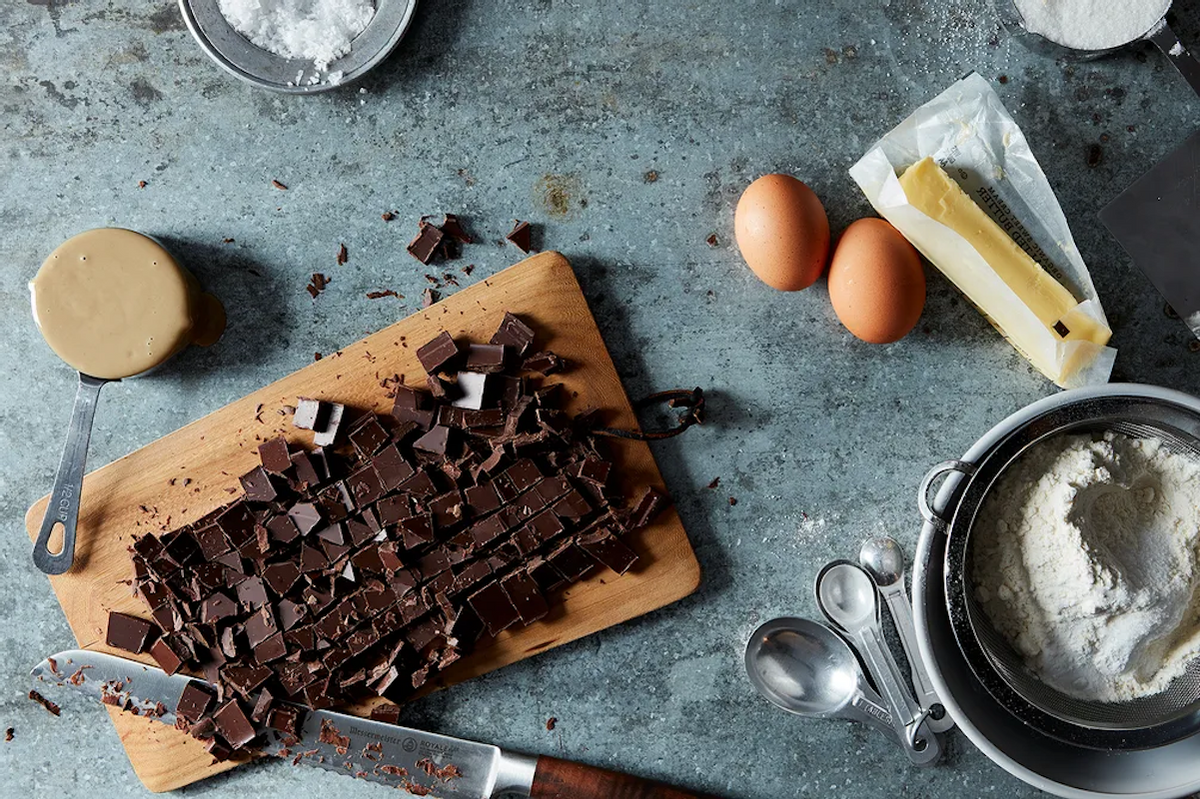Do you ever just want to melt chocolate chips and I don't know, like, eat the puddle of semi-sweet chocolate by the spoonful? Same. Biscotti are better when dipped in melted chocolate, as are coconut macaroons. Melt chocolate chips in the microwave, then fold the gooey mixture into brownie batter for a super fudgy dessert. Dip potato chips into melted chocolate and let it harden for the perfect salty-sweet snack. We're on the same page that there's not much that melted chocolate can't make more delicious, right? Good. So there's only one thing left to discuss: our best tips and tricks for melting chocolate chips.
Chocolate chips vs. baking chocolate
In general, chocolate chips will have added ingredients such as sugar, cocoa butter, milkfat, soy lecithin, and natural flavors. High-quality baking chocolate will contain basically the same breakdown of ingredients, with the exception of milkfat and added flavors. When choosing baking chocolate to temper, use high-quality dark chocolate that contains 60% to 72% cacao.
Chocolate can easily veer into overcomplicated culinary techniques, but we try to keep it as unfussy as possible. That means that if a recipe for brownies or cookies calls for melted chocolate, use what you have on hand and what you love. Obviously, if a recipe specifies using milk chocolate chips, like our Chocolatey Tahini Cups, or bittersweet chocolate (like Dorie Greenspan's Top Secret Chocolate Mousse, then use that.
How to melt chocolate chips
On the stovetop
Traditionally, melting chocolate is done over a bain-marie, aka a double boiler. A heat-proof glass bowl, such as sturdy Pyrex, is set over a deep pot filled with about an inch of water. Chocolate chunks are added and slowly melt, thanks to the heat of the simmering water beneath it. Make sure that the water never comes to a boil and that the bowl does not touch the water; if it gets to be too hot, you'll be more likely to burn the chocolate. It's also important to stir the chocolate consistently for the same reason. Within five minutes, you'll have a shallow pool of melted chocolate that is shiny as a head of brunette hair in a Pantene commercial.
In the microwave
The easier, but less formal (aka French) way of melting chocolate is in the microwave. Pour a bag of chocolate chips or chopped chocolate in a glass bowl, then place it in the microwave and heat it up. You can also use a stainless steel bowl, so long as it doesn't touch the sides of the microwave (mindblowing, I know). Every 30 seconds, stop the microwave and stir the chocolate with a wooden spoon or spatula. This will ensure that the chocolate chips and newly melted chocolate are well-incorporated; plus, you'll be less likely to overheat the chocolate, which would otherwise result in a sad, sticky, sloppy mess or burnt chocolate.
Safety tip: wear oven mitts or use potholders when you remove the bowl from the microwave or bain-marie, as it will be super hot. For the same reason, rest it on a trivet to protect your countertops, too.
Wait, but what does tempering chocolate mean?
So how does melting chocolate in the microwave differ from the fancy French technique known as "tempering?" Both are a method of achieving glossy, silky melted chocolate but tempering requires more of a careful hand . . . and the results are usually better.
Tempering chocolate involves heating and melting chocolate chunks over a bain marie, cooling some of the melted chocolate or incorporating new, unmelted chocolate chunks, and whisking furiously until the mixture comes together. You'll know the chocolate is tempered when it reaches 90 degrees Fahrenheit (check this using a candy thermometer or meat thermometer).
While you can get away with simply melting chocolate for the majority of your cooking and baking, you'll need to temper your chocolate to delve into the world of confections. That's a story for another day, though — after all, we're here for melted chocolate, stat.




Shares